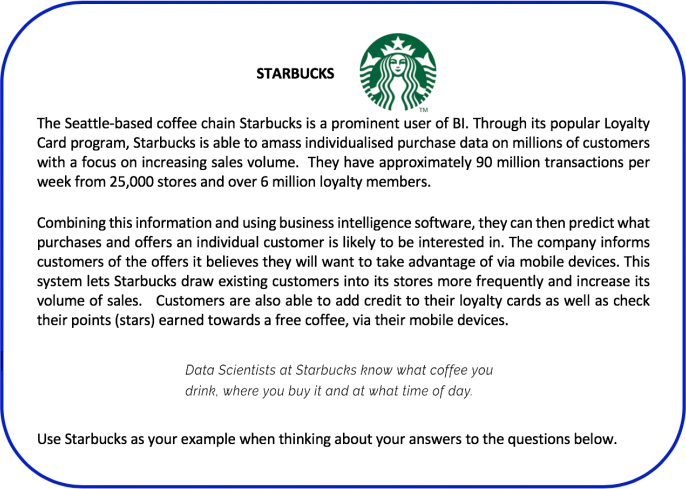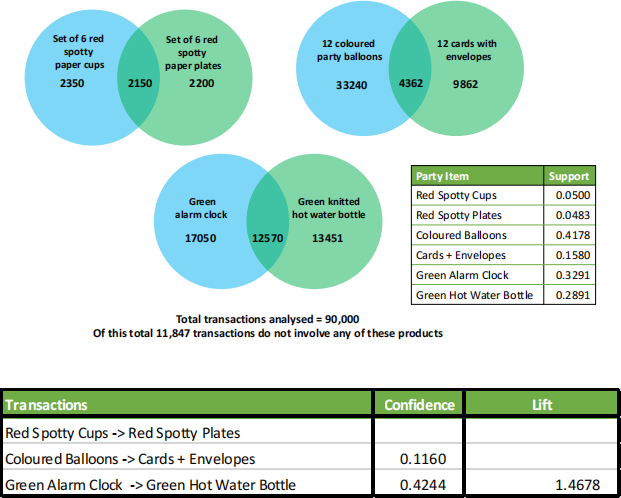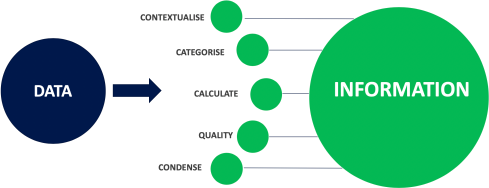INFS 2036 Business Intelligence Exam Practice Questions
Hello, dear friend, you can consult us at any time if you have any questions, add WeChat: daixieit
INFS 2036 Business Intelligence
Exam Practice Questions
The Case Study Practice Section is designed to give you practice with answering case study questions. In the exam all case studies and visualisations will be new so don’t expect a Starbucks case study J
The General Questions Section contains Business Intelligence questions takenfrom topics covered in the Workshop slides, Practical Discussions and/or tests as well the indicated readings/resources. Any visualisation you are given to discuss in the exam will be new so don’t expect a Boeing Traffic Flow visualisation as you’ve been given here J
PART A: Case Study Practice Questions
Read thefollowing case study and answer the questions below.

1. Write a relevant priority for this case study.
2. Name two ways BI can help this organisation achieve this priority.
3. List two descriptive questions the dashboard should be able to answer.
4. List two diagnostic questions the dashboard should be able to answer.
5. List two predictive analytics questions the dashboard should be able to answer.
6. List four data items you would need to use in the dashboard to support your priority.
7. List one internal data item and one external data item you could use to support your priority.
8. Name one data standard that could be used in this BI project.
9. Name one example of a data set that could be shared in this case study to better support your priority. Indicate whether the data is likely to be internal/external and structured/unstructured. How could you ensure data collection consent if needed?
10. What would you recommend putting in place to ensure there is sufficient consent for sharing the data?
11. List three possible metrics that could be included in a dashboard to support your priority.
12. Using one of the metrics from 11, write a performance indicator that could be included in a dashboard for your priority.
13. What are two things you could do to make this BI Project more successful?
14. Give one reason this BI project could fail.
15. List two potential issues with data quality arising from this process.
16. Name two stakeholders in this project.
17. Name two end users of this project.
18. Discuss how the four phases of Business Performance apply to the case study.
19. Explain in your own words the difference between Business Intelligence and Business Analytics in the context ofyour priority.
20. Write an elementary-level question at the operational level of decision making relating to your priority.
21. Write an overall-level question at the strategic level of decision making relating to your priority.
22. Explain, in your own words, the difference between waterfall and agile information system development approaches in the context ofyour priority.
23. Use the performance indicator written for Question 12 to create an impact diagram. This indicator will play the role of the KPI for this diagram.
Break this diagram down into two more levels and at each level, give two metrics that would support the Key Performance Indicator.
For this question assume all but one of the metrics are performing above target, with one performing below target, however you do not need to use colour coding in your answer, just the appropriate shape (circle, diamond, square).
24. Discuss any ethics consideration(s) that should be applied in relation to your priority for this case study.
25. Discuss any privacy consideration(s) that should be applied in relation to your chosen Priority for this case study.
26. What system would need to be implemented if Starbucks would like a marketing algorithm to learn patterns of behaviours to enable the prediction of a customer’s preference on a set of product items that were never purchased before? What two types of sales could Starbucks use this system for? Give one example of each.
27. One of the common Fatal Flaws of a BI Project is the temptation to use an out-of-the- box dashboard that can build dashboards in a few hours. Explain briefly why this is an issue and what can be done to address this flaw.
28. Starbucks would like to predict the most popular type of Frappuccino® offered by the flagship store in Sydney. If there are at least 4 different types of Frappuccino® coffee offered what type of classification problem is this. What type of regression model should be used for this prediction?
29. Starbucks would like to predict the daily sales for a new store. Give one variable that could be used to perform this prediction and the type of regression model that should be used.
30. If you would like to perform a prediction using a logistic regression model suggest one variable of interest to predict for this case study including how it will be recorded.
31. Starbucks would like to use a regression model that captures the influences affecting sales volume. Write a full regression model to predict sales volume using three variables that could influence sales volume.
32. Starbucks records how often customers visit their local store and is storing the possible outcomes as: < 2 days per week, 2-5 days per week and > 5 days per week.
What type of regression model should Starbucks use for prediction? Explain briefly. Write a sample model for how often customers visit their local store and include two variables that could influence this metric.
33. Use the output below from Market Basket Analysis to describe the association using the lift score between {Pumpkin Spice Latte−> Cheese Toastie}. If you would like to suggest a marketing campaign, which products would you promote together?

34. How would the ETL process support the creation of Business Intelligence for Starbucks? Name two key success factors in implementing a high-performance ETL process for Starbucks.
35. How would Starbucks use a Data Warehouse in this instance in support of Business Intelligence?
36. How could the Internet of Things offer an opportunity for innovation for Starbucks to get ahead of their rivals? Are there any concerns with ethics or consent with your proposed solution?
PART B: General BI Practice Questions
1. Name the 10 steps of the BI Process.
2. Why do organisations need data analytics and data mining in a competitive business environment? Name two reasons. Why has Business Intelligence become important for organisations?
3. What are the two main information system development approaches in the BI Project lifecycle? Describe each one briefly. What are three advantages and disadvantages of each?
4. What is the difference between a metric and a performance indicator? Give one example of each as it would relate to hospital patient care in an emergency ward.
5. Give the four fundamental questions used when considering ethical reasoning.
6. In your own words describe the difference between content and collaborative filtering as used for recommender systems. Give one example of each type of filtering.
7. Name and describe a type of natural language processing analysis. Give one example application that would use natural language processing analysis.
8. Describe, in your own words, the difference between structured and unstructured decision- making including the relevant managerial level(s) involved. Give one example in the context of an airline wishing to encourage increased passenger travel during the summer months.
9. Describe, in your own words, the difference between a Complex and Complicated problem, as represented by the Cynefin framework in the context of Apple releasing a new iPhone.
10. Describe, in your own words, the purpose of Effectiveness when adopted as an AI Business strategy. Give one example in the context of a suburban restaurant wishing to adopt AI for customer service. By considering the work complexity and data requirements for Effectiveness, identify one challenge the restaurant may face.
11. The focus of the 4 AI Business strategies is to either automate or augment human behaviour. List each of these strategies and indicate whether they support automation or augmentation.
12. What is metadata? Give one example of metadata (i.e. choose either structural, descriptive or administrative metadata for your example).
13. Name two capabilities of data quality tools.
14. A café located on a busy city street specialises in baking and selling pastries. How could the Internet of Things offer an opportunity for innovation for the café to grow their business?
Suggest two examples that is applicable to this business.
Questions 15 – 19 are based on the visualisation in Figure 1
15. Who do you think is the intended audience for this visualisation?
16. Make two suggestions how to improve this visualisation for that intended audience.
17. Suggest one filter that could be added to this dashboard and what insights it would give the dashboard user.
18. For the visualisation Traffic Flows 2016 apply the data cube as shown below and indicate which components of a data slice are used (occasion, entity, characteristic). In your answer
ensure you indicate which part of this visualisation you are referring to.
19. For the visualisation 2016 Traffic 2036 Added Traffic (bottom right of dashboard) apply the data cube as shown below and indicate which components of a data slice are used (occasion, entity, characteristic). In your answer ensure you indicate which part of this visualisation you are referring to.

![]()
![]()
![]()
![]()
![]()
![]()
![]()
![]()
![]()
![]()
|
|
|
|
|
|
|
|
|
|
|
|
|
|
Figure 1:Passenger Traffic Growth by Regional Flow for Boeing. In Boeing's first visualisation on Tableau Public, the Fortune 100 companyforecasts airplane demandfor the next 20 years.
Questions 20 onwards are separate to Figure 1
20. A small retail store trading seven days each week wishes to predict the time taken to serve customers to ensure enough staff are rostered on. For the analysis the store has recorded the days of the week as Mon- Wed, Thu-Fri and Sat-Sun.
Based on your answer what type of prediction model would you use? Explain briefly.
Write a regression model that indicates, using weightings of your own choosing, that Sat-Sun are the busiest days, then Thu-Fri and then Mon-Wed.
21. Tables 1 and 2 below show the number of active users and average daily time spent on selected social media platforms for a YouTube channel. Use these tables to answer the question below.

Explain how an inner join works in your own words.
Which option below (Join 1, Join 2, Join 3) will be the result of an inner join of Tables 1 and 2 in Tableau?

22. The transactions for an online transnational retailer selling unique all-occasion gifts and party decorations. A summary of a selection of their product sales is given below. Use the summaries to complete the values for confidence, support and lift where shown below. Which party products would you cross-sell as part of the retailer recommender system? Explain briefly by commenting on each product combination including referencing values from the completed table as needed.

23. The transactions for an online store selling Apple products are given below. A summary of a selection of their product sales is given below. Use the summaries to complete the values for confidence, support and lift where shown below. Which Apple products would you cross- sell as part of the retailer recommender system? Explain briefly by commenting on each product combination including referencing values from the completed table as needed.

24. A local supermarket manager has collected data on items purchased by customers. Explain two ways in which the manager can convert this data into information. Accompany each explanation with a relevant supermarket example.

25. A local supermarket manager has collected data on items purchased by customers. The manager would also like to understand why customers choose this supermarket and has asked them to answer a short survey at the checkout about their shopping experience. The purchases data will be joined with the survey data for further analysis.
List one potential issue with making the data Useable in this application.
Other Revision/Reading
• Practical discussion slides from Weeks 2-9
• Workshop slides — in particular the Focus On sections and diagrams throughout each workshop J
• Tests and test solutions J
2023-05-20